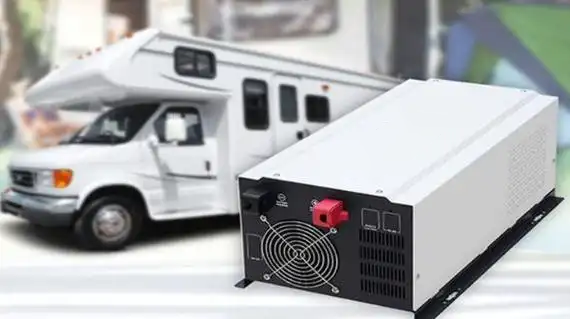 |
Welcome To Evlithium Best Store For Lithium Iron Phosphate (LiFePO4) Battery |
 |

In the world of RV living, having the right equipment can make a significant difference in comfort and convenience. One critical device every RV enthusiast should consider is an inverter. Let’s explore why an inverter is a must-have, how it works, and the different types available to suit your needs.
An inverter is an electronic device that converts low-voltage direct current (DC) from your RV’s battery into high-voltage alternating current (AC), typically 220 volts. This conversion is crucial because most household appliances and devices require AC power to operate. While daily electrical systems often rectify AC to DC, an inverter performs the opposite function, which is why it’s called an “inverter.”
In today’s mobile-driven lifestyle, having access to both DC and AC power is essential. From mobile offices to entertainment on the go, an inverter ensures that you can power everything from your laptop to your coffee maker, making life on the road more seamless and enjoyable.
Inverters are classified into two main types based on their output waveform: sine wave inverters and square wave inverters. Let’s dive deeper into their characteristics:
A sine wave inverter produces AC power that closely mimics the power supplied by the grid. This type of inverter is ideal for running sensitive electronic devices, as it doesn’t generate electromagnetic interference. Sine wave inverters provide stable and high-quality power, making them suitable for all types of electrical loads. However, they are more expensive and technically advanced.
Square wave inverters generate a less stable and lower-quality AC power. Their waveform switches abruptly between maximum positive and negative values, which can cause instability in the devices they power. These inverters are less efficient and can only handle loads at 40-60% of their rated capacity. Additionally, they are not suitable for inductive loads, as the sharp transitions in the waveform can damage the devices.
Modified sine wave inverters fall between sine wave and square wave inverters. Their waveform resembles a series of broken lines rather than smooth transitions. While not as high-quality as sine wave inverters, they provide a cost-effective and efficient solution for most electrical needs. They work well with devices such as laptops, chargers, and small kitchen appliances but are not ideal for sensitive or inductive loads.
Inductive loads refer to devices that operate based on electromagnetic induction, such as motors, compressors, and fluorescent lights. These appliances demand a much higher starting current—typically 3-7 times their operating current—to initiate operation. For instance, a refrigerator consuming 100 watts during normal operation may require over 900 watts to start.
The back electromotive force generated when powering on or off an inductive load can exceed the voltage capacity of many inverters, potentially causing overloads and reducing the inverter’s lifespan. Therefore, devices with inductive loads require an inverter with a robust power supply and a suitable waveform.
Modified sine wave inverters can power a wide range of devices, making them a popular choice for RVs. Here’s a breakdown of their applications:
Ideal Uses: These inverters are suitable for laptops, televisions, video cameras, digital cameras, printers, and various chargers. Larger modified sine wave inverters can also handle small electric heating devices such as hair dryers, electric kettles, and some kitchen appliances.
Limitations: While versatile, modified sine wave inverters are not recommended for powering inductive loads such as refrigerators, electric drills, or other high-power appliances for extended periods. Doing so could damage the inverter or shorten its lifespan, as well as that of the connected devices.
When selecting an inverter, consider the type of devices you plan to power and the quality of power they require. A sine wave inverter is a reliable choice for those who need stable, high-quality power for sensitive electronics. However, if you’re looking for a budget-friendly option that meets most basic needs, a modified sine wave inverter may be the perfect solution.
Additionally, ensure your inverter’s power output matches or exceeds the demands of your appliances, especially those with inductive loads. Investing in the right inverter will not only enhance your RV experience but also protect your devices and prolong the life of your power system.
An inverter is an indispensable tool for any RV owner, providing the flexibility to power essential devices and appliances while on the move. Understanding the differences between sine wave, square wave, and modified sine wave inverters will help you make an informed decision based on your specific needs. By choosing the right inverter, you can enjoy the freedom of mobile living without compromising on comfort or convenience.
Edit by paco
All Rights reserved © 2025 Evlithium Limited